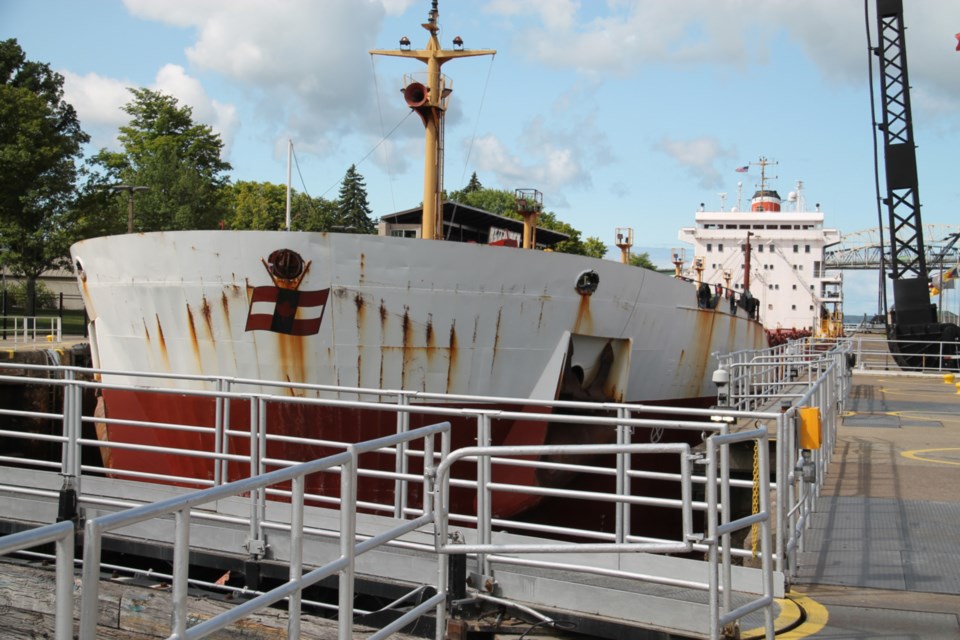A high level group of U.S. political, military and business leaders toured the Soo Locks and held a roundtable discussion inside the Locks administration building Friday to provide Sault, Mich. officials with an update on the long-awaited, much-needed $1 billion Locks expansion.
“The good news is that in the U.S. House of Representatives we have secured over $75 million for the upcoming fiscal year to significantly advance the investments here in Sault, Michigan for the Locks improvements that have been on the books for decades now,” said Rep. Marcy Kaptur, Democratic Congresswoman for Ohio’s Ninth Congressional District, speaking to SooToday.
Kaptur serves as the House Appropriations Subcommittee on Energy and Water Development chair.
“They’ve been doing repair work, but we’re talking about replacement, a new lock, complete modernization. It looks very good from the standpoint of the House, now it’s gone to the United States Senate, and we’re depending on our Senators (to approve the funding), then we can move forward and send the bill to the President for signature, hopefully by October,” Kaptur said.
Previously, President Donald Trump included a request of $75.3 million to continue Lock construction in 2020.
The request appears to be a promise kept by Trump, who has often mentioned the need to build a new lock.
“We didn’t have trouble with the administration. The Michigan delegation, including our two Michigan senators...were able to get the administration not to make it more difficult. Congress has provided the necessary funding, more than in past years. Everything looks like a go now, we’ve just got to get it through the Senate,” Kaptur said.
“This is the biggest boost the project has had in decades. I think this is a very strong lead forward going into 2020.”
The Locks expansion was first approved in 1986, but has suffered numerous delays because of a lack of funding since then.
The next step after approval of the funding is the awarding of the contract to builders for the Locks upstream approach walls construction, explained Rep. John Moolenaar, a Republican Congressman for Michigan’s Fourth Congressional District, a member of the House Appropriations Committee who accompanied Kaptur to Friday’s Locks tour and roundtable.
“We’ve made major progress, and we’re on the ground floor, but we’ve got a way to go yet. I am confident. I think there’s an alignment between the executive branch, the Congress and the U.S. Army Corps of Engineers (which operates the Soo Locks), who have prioritized this right at the top of their list of work plans. We’ve got strong momentum, but it’s a multi-year project that needs continued advocacy and support,” Moolenaar told us.
“This year we’re doing billions of dollars in work, about 10,000 projects...of all the projects we’re doing, this is one of the most important projects I’m concerned about,” said Lieutenant General Todd Semonite, commanding general of the U.S. Army Corps of Engineers, addressing an audience of Sault, Michigan leaders at the roundtable.
“It’s important Congress and the administration understands not just the capability of this important lock but the risk that comes with that.”
“This system is very, very old. We have ships coming through here with about 90 per cent of the iron ore this country needs to do our job. Right now the big ships can only come through the Poe Lock, and it’s over 50 years old (first built in the 19th century, rebuilt in 1968)...we’re questioning how long we can keep that going,” Semonite said.
The MacArthur Lock can accommodate smaller vessels, while the Sabin Lock remains closed, the Davis Lock decommissioned.
“The whole point is to build a second lock. If we can’t get that second lock done, and if there ever was a failure (with the Poe Lock), the ramifications for jobs, for steel mills, in unemployment, would be significant. This could be a crisis for the nation,” Semonite said.
“We think if we get full funding, in eight or nine years from now, in about 2028...this lock will get done.”
Approximately 80 million tons of commercial commodities, such as iron, coal, grain and other materials pass through the Soo Locks annually, more than 80 per cent of that tonnage passing through the Poe Lock.
The Congress members and Semonite were joined by other high-ranking U.S. Army Corps of Engineers officers and business leaders Patrick Bloom of mining company Cleveland Cliffs, William Freidman, American Association of Port Authorities (AAPA) board chairman and Jim Weakley, Lake Carriers Association president, each of them underlining the vital importance of the Soo Locks expansion to business.
A structural failure at the Poe Lock, Weakley said, would not only spell disaster for the U.S. economy but also Canada and Mexico, stating millions of people would lose their jobs.
The new lock would be 1,200 feet long, 110 feet wide and 32 feet deep.
Prior to 2018, funding for the renovation of the Poe Lock and construction of the new lock project received $32 million for design and planning and downstream channel deepening, with a further $69 million in 2019 (a mix of federal and state government funding).
With federal government and presidential approval in 2020, another $75 million will go toward the project, with another $14 million to possibly be added to that total.
It is hoped a further $173 million will be approved in 2021, $129 million in 2022.
$536 million would be needed from 2023 to 2028 to complete the new lock construction.
The Poe Lock would remain in operation after the new lock is built.
